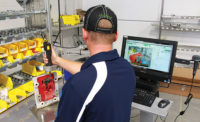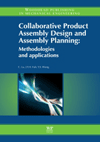Mastering Mixed-Model Assembly

Mixed-model assembly lines are common in many different industries today. While they present numerous opportunities for manufacturers, they also create headaches for engineers. ASSEMBLY recently asked Drew Locher, a lean manufacturing expert and director of Change Management Associates, to share some insight on the topic.
ASSEMBLY: How do you define “mixed-model assembly"?
Locher: Producing relatively short runs or low volumes of different products on the same production line or equipment in the same shift or day. It poses a challenge for most organizations due to the relatively high variability that arises.
ASSEMBLY: What are some of the key characteristics of lean, mixed-model assembly lines?
Locher: Outstanding workplace organization, and the ability to change over quickly. This isn't always just about equipment changeover, but also materials and staffing.
For example, in one company that made surgical instruments, more than 150 different products were made on the same manual and machine assembly cell, with as many as 20 different ones in a single shift. Staffing scenarios were worked out for each that maintained balance and flow throughout the cell when they changed from one product to another. They would lose at most two minutes every changeover. It was a well-choreographed changeover process that involved some equipment change, but also movement of associates to different stations that were already set up. A small playbook with single-page visual depictions of the cell set up was created for each group of similar products.
ASSEMBLY: What is the biggest challenge to creating high-mix assembly lines?
Locher: To not focus on the differences, but rather the similarities of the processing requirements of the various products. In the example above, there were about 24 groups of products that shared similar processing requirements. That’s a much easier figure to deal with than 150.
This requires time to really look at the processes for each product, recognize the similarities and come up with creative solutions to deal with the differences of significance. Differences of work content variation of less than +/-30 percent can easily be worked out. But, this is just a general guideline.
At a high-mix sand cast foundry, finishing lines were put in that could accommodate up to 300 percent variation in work content. The equipment layout was designed to allow for flexible staffing. The key was to recognize the products being scheduled and develop the choreography ahead of time. As a shop, they could do up to 25 different jobs a shift. A single line might see as many as eight different products in a shift. They grouped the products into categories referred to as 1:1:1, 1:1:2, 1:1:3 and 1:1:4, which indicated how the lines should be staffed to optimize flow.
ASSEMBLY: What is the most important lean component in a mixed-model assembly system?
Locher: Certainly quick changeover or SMED concepts. Standardized work for each product, as well, which is a challenge due to the number of products. Training and cross training associates in the standard work is also critical.
Level scheduling of the mix of products can result in more consistent and predictable output. In other words, running different but similar products after each other can really help minimize the impact of the variability. So, this is a major consideration in scheduling high-mix assembly lines.
Mistake-proofing or poke yoke techniques are welcomed in all applications, but particularly in high-mix model situations where the potential for error increases.
Light-assisted assembly was created to prevent or at least minimize errors. Equipment has also been designed to ensure that the correct part is retrieved to be assembled.
Pull/Kanban can be important in some mixed-model environments to maintain balance between operations or even departments. Standard work in process (SWIP) is established at key points (queues) of the process. Work is not pushed forward if the queue has reached a maximum limit. The supplying process either stops or works on a different job that requires different equipment or operations than the one backed up. Coupled with level scheduling of the mix of products, output can be optimized by use of such pull systems. In other words, don't create a schedule that will bury a particular operation. Level schedule the mix of products in such a way to avoid this as much as possible.
The application of takt time is difficult in a high-mix environment. However, it is very important to do so in order to monitor overall demand vs. capacity. This is important so that published or promised lead times can be maintained, particularly in build-to-order environments. The key is to focus on the known constraints (which can move in a high-mix environment) and find a meaningful expression of demand that if monitored can be compared to existing capacity.
At a high-mix wood fabricator and assembler, the expression of demand was in terms of dollars of the order, because it was proven to relate to the work content needed to assemble the product. In a high-mix electronics company, it was the number of parts for each assembly on the pick-and-place equipment since that determined the output of the overall production system. Once the “Rosetta Stone” for demand has been found, the system can be managed accordingly.
At the production line itself, takt time, which is often used to establish a pace to the work, becomes less useful. However, plan vs. actual boards can still be established, which meets this need. Just keep in mind the plan may vary based on the model being run.
ASSEMBLY: What type of production tools typically play the most important role in achieving mixed-model assembly processes?
Locher: It really depends on the application. In all cases, visual work instructions top the list. The dependency on information is much greater in a high mix-model environment. People simply cannot go by memory.
ASSEMBLY: What is the biggest mistake that engineers make when it comes to implementing flexible production systems?
Locher: Equipment design can be a real issue. Not considering changeover in the design remains an issue, but much less than it used to be. Too many bells and whistles that are not really necessary can greatly add to changeover time. Trying to automate everything. Humans still tend to be more flexible than equipment. However, some machine designers don't believe that.
Other than that, it is the belief that it cannot be done—that mixed models cannot co-exist on the same line. This comes from the tendency mentioned earlier to focus on the differences rather than the similarities between products.
Looking for a reprint of this article?
From high-res PDFs to custom plaques, order your copy today!









